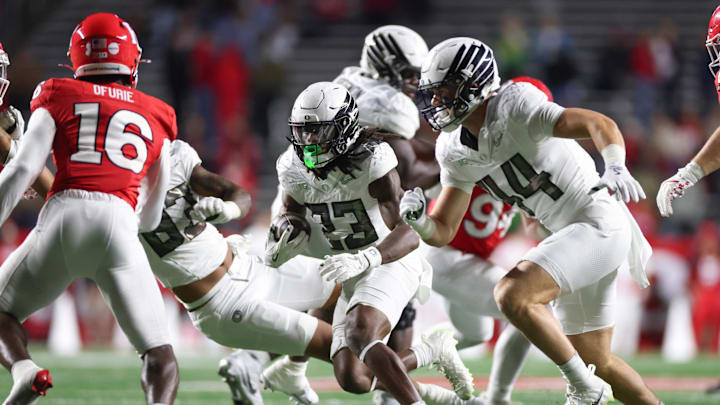Defense wins championships. Every national champion in the last 10 years has ranked in the Top 31 in scoring defense and yards per play, and most have been far better than that, elite, intimidating, disruptive.
College Football National Champions, defensive performance
Year | Champion | YPP (Rank) | Scoring (Rank) |
|---|---|---|---|
2024 | Ohio State | 4.19 (1st) | 12.9 (1st) |
2023 | Michigan | 4.28 (4th) | 10.4 (1st) |
2022 | Georgia | 4.88 (15th) | 14.3 (5th) |
2021 | Georgia | 4.15 (5th) | 10.2 (1st) |
2020 | Alabama | 5.04 (20th) | 19.4 (13th) |
2019 | LSU | 5.11 (29th) | 21.9 (31st) |
2018 | Clemson | 4.19 (2nd) | 13.2 (1st) |
2017 | Alabama | 3.99 (1st) | 11.9 (1st) |
2016 | Clemson | 4.63 (5th) | 18.0 (10th) |
2015 | Alabama | 4.1 (1st) | 13.4 (1st) |
Statistical rankings from cfbstats.com.
Defense travels. It performs in all weathers, creates field position advantages and establishes an identity for a football team. The 2019 LSU and 2020 Alabama squads were outliers that relied on high-volume passing attacks and record-setting scoring on offense.
DeVonta Smith and Joe Burrow won Heisman Trophies in those seasons with insane production. Smith scored 23 receiving touchdowns, 117 catches for 1,856 yards. Burrow threw for 5,671 yards and 60 touchdowns.
In those seasons the SEC embraced tempo and video game productivity. While still important, defense took a back seat.
In 2025 the pace has slowed, parity rules and defense is as important as ever. Defending national champion Ohio State, 7-0 and No. 1 in both polls, ranks first in scoring defense at 5.9 points a game and No. 3 in yards per play defense at 3.81.
Oregon's not far off. The Ducks have a strong defense statistically, No. 5 in yards per play at 4.06, No. 8 in scoring defense at 14.4 points per game.
Brandon Gibson of Scoop Duck makes an interesting point about the Ducks D so far in 2025:
Fun facts:
— Duck Sports On3 (@DuckSportsSD) October 24, 2025
59 of Oregon's allowed 91 points (64.8%) have come in the 4th quarter or overtime pic.twitter.com/PiXTiDC9nH
Five of Oregon's games have been blowouts where Dan Lanning and company have gone deep into the bench in the fourth quarter, aiding in depth and development. However, against Indiana and Penn State the first-team defense faltered in the fourth quarter, giving up 10 and 14 points in close games, a 30-20 loss and a 30-24 double overtime win.
In both, the defense gave up long drives in the final period with a chance to put the game away.
Saturday's game with Wisconsin is a prime opportunity for the defense to assert itself against an opponent that's been shut out in each of their last two games. The Badgers rank dead last in the Big Ten in scoring offense at 13.3 points per game.
They're 17th throwing the football with a passer rating of 115.8, last running the football 3.13 yards per carry. Injuries at quarterback have made UW punchless, 0-4 in the Big Ten.
The Ducks should come out of this matchup feeling pretty good about themselves defensively. Immediately after they'll go into their second bye week of the season before traveling to Iowa on November 8.
In terms of preparing for playoff football, the November schedule is perfect with a bye to get healthy, followed by four good-but-not-great opponents, Iowa, Minnesota, USC and Washington, all presently 5-2.
Iowa boasts a tough defense and one of the best offensive lines in the country. Minnesota is a well-coached, middle-of-the-pack team with a decent defense and a deliberate offense. Complicating that matchup is the fact that they play the Gophers on a Friday night coming off the road trip to Iowa.
In USC and Washington the Ducks have two opponents who will test them with potent offenses. SC is No. 3 in the league in scoring offense at 42.4 points per game, led by quarterback Jayden Maiava and two outstanding wide receivers, Makai Lemon and Ja'Kobi Lane.
The Huskies get the Ducks at home, and the challenge there is to contain their big three of quarterback Demond Williams, running back Jonah Coleman and wide receiver Denzel Boston.
These are five games Oregon should win, but each will command attention. They'll provide matchup challenges that create opportunities for improvement in key areas:
1. Getting off the field on third down, particularly third and short yardage.
2. Meeting ball carriers in the A and B gap and knocking them back.
3. Dealing with a strong offensive line in a tough environment in the Iowa game.
4. Matching up with elite receivers.
5. Finishing strong in the fourth quarter
6. Fostering the depth and continued development of young players like linebacker Dylan Williams, safety Trey McNutt and cornerbacks Ify Obidegwu and Na'eem Offord.
7. Generating more havoc and disruption. Surprisingly, the Ducks rank 10th in the conference in sacks with 13, 12th in tackles for loss with 34. Their elite edge rushers haven't gotten home as often as expected, though Teitum Tuioti and Blake Purchase had strong games against Rutgers.
Down the stretch, this group needs to finish more plays for Oregon to truly be considered an elite defense. They've got to bring the intimidation factor.
Elite defense starts with linebacker play. Run fits, flowing to the A and B gap, meeting runners in the hole and disrupting the passing lanes are areas where this group can grow. Dylan Williams' return to the lineup and his promising 2025 debut against the Scarlet Knights (five tackles, 1.5 tackles for loss) could help elevate this group.
